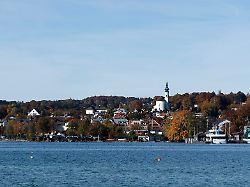Relative wealth in the countryside?
Expensive cities eat up purchasing power
November 6, 2023, 9:17 a.m
Where many rich people live, life is often expensive. Does this compensate for regional income differences? Only partially, as a new regional purchasing power ranking shows. Current data shows: Most large cities are falling drastically.
Wealth is relative: In Germany, there are significant regional differences in freely disposable income, according to a current data analysis by the German Economic Institute (IW). The regional cost of living in particular quickly eats up salary advantages, as the detailed analysis by economic researchers shows.
How wealthy or poor someone is depends not only on their income, but above all on their chosen place of residence. There is a clear distribution in the ranking of the regions with the highest average disposable income. According to IW data, the municipality of Starnberg in the southwest of Munich, which is known to be particularly wealthy, is at the forefront nationwide. Starnberg is 34.7 percent above the national average. The IW ranking has the lowest nationwide level of price-adjusted disposable income for Gelsenkirchen. The values there are 22.5 percent below the German average.
The next highest real incomes are in the Hochtaunuskreis, Baden-Baden and the districts of Miesbach and Munich. The lowest after Gelsenkirchen in Offenbach, Duisburg, Herne and Freiburg. However, if the researchers take the local cost of living into account – the amount of which varies considerably due to rents and taxes – then the German ranking of relative prosperity looks completely different.
Richer place to live, higher costs
The underlying mechanism is simple: Anyone who lives in a municipality with low taxes and cheap rents or real estate prices, even with a comparatively lower income, has more money at their disposal at the end of the month than with a comparable income in Starnberg, for example. In this way, differences in the cost of living can offset some of the income differences.
The city of Munich, for example, is in second place nationwide in terms of income. Because the cost of living there is 25.1 percent above the national average, the Bavarian capital only ranks 24th when adjusted for prices. Other large cities fall even further due to the price adjustment: Stuttgart falls 259 places: 301st instead of 42nd For Frankfurt am Main it goes from 118 to 370, for Hamburg from 64 to 297.
In return, favorable districts rise to the top: in the data analysis by the IW researchers, for example Tirschenreuth far out of midfield in the north-east of Bavaria. Thanks to local low prices, the idyllic location gained 140 places and jumped up to 60th place. The Vulkaneifel district far to the west improved by 139 places, Cochem-Zell – also in Rhineland-Palatinate – by 135 and the districts of Hof and Regen (both in Bavaria) by 133 and 132 positions respectively.
Starnberg in first place
According to IW calculations, the highest available annual income in regional prices can be found in the Bavarian district of Starnberg at just over 32,800 euros. That is 34.7 percent more than the national average. Starnberg is already number one in terms of nominal income and the lead is simply so large that it is not offset by the high cost of living, which is 14.1 percent above the national average.
The next four places are also occupied by cities, districts or districts that are already way ahead in terms of nominal income: the Hochtaunuskreis 27.1 percent above the national average, Baden-Baden with 26.5 and the districts of Miesbach and Munich with 19.8 and 18.6 percent above average price-adjusted income.
The IW experts calculate the lowest price-adjusted available annual income for Gelsenkirchen. At 18,886 euros, it is 22.5 percent below the national average. The city already had the Red Lantern before the price adjustment. The 5.1 percent below-average costs there don’t change anything. This is followed by Offenbach am Main, Duisburg, Herne and Freiburg, which are 21.7 to 16.2 percent below the national average.
The two German extremes, Starnberg and Gelsenkirchen, remain stable in their positions even when the regional cost of living is taken into account. In the middle field, the weighted ranking based on disposable income (minus living costs) confuses things quite a bit. However, this is also due to the fact that the differences in the mass of German regions are sometimes relatively small. Overall, the regional costs level out the income differences to some extent. “The spread is getting smaller,” explains Christoph Schröder from the IW. The differences between East and West also decreased.
Even in rural areas, people often have a good income, says Schröder. The Olpe district in North Rhine-Westphalia, for example, is in 25th place in terms of nominal income. Together with the cost of living below the average, that’s enough for ninth place in real income.
The comprehensive data analysis was made possible by extensive preparatory work: The data on nominal income, for example, comes entirely from the Federal Statistical Office as of 2021. The IW Institute compiled this data set with a recent report from it together with the Federal Institute for Building, Urban and Spatial Research (BBSR) published index of the regional cost of living at the district, district and city level. The price index is based, among other things, on 24 million price data collected, some of which were automated, in 2022. Housing costs were the deciding factor for larger differences. The ranking does not take into account differences in the expenditure structure, for example, city dwellers may have lower commuting costs than people from cheaper rural areas.
